Description
Product Description
Overview
The all-new Roland GP-6 is a digital baby grand equipped with the newest generation of sound reproduction technology, as well as a wood-hybrid digital key action which closely mimic’s the touch and weight of a real acoustic baby grand (Piano Reality Premium Keyboard Action). It’s cabinet is built using the same materials that real pianos use, and the overall fit and finish of the entire build suggests an expected lifespan of well over 10+ years.
The GP-6 features a multitude of new innovations which bring its level of musical authenticity to an unmatched level for it’s category and price. The sound engine is a completely re-invented computer model which generates tone in real time based on a players every input and nuance (Piano Reality Premium Tone Engine). An enhanced stereo image the player now has at the keyboard is enhanced both by an all-new tone engine algorithm with multi-channel output, but also a new set of front-facing tweeters which actively resonate the front panels of the piano, creating a truly authentic sense of cabinet resonance.
And finally, the GP-6 is highly versatile, able to satisfy the hard-hitting percussive rhythms of rock, blues, or jazz players with tons of power and a clear bass, while at the same time delivering a delicacy and nuance through the lower dynamic ranges that will surprise even the harshest digital piano critics.
Piano Action
Roland has completely overhauled their actions and tone engines right across the entire company, and starting with these GP models. What used to be known as the PHA-50 is now known as the Piano Reality Premium Keyboard Action. But it’s more than just a re-branded PHA-50. The sensors have been accelerated and the cushioning improved. When playing the new action and trying to pay attention to these improvements, the changes seem subtle. But then again, the difference between a truly connective action and one that simply feels lifeless is entirely in those subtle changes.
The other features that made the PHA-50 such a remarkable action continue on into the new Piano Reality Premium, such as the stabilizer pin, the lengthened key sticks, the partial wood core, and the acoustic-like black and white key surfaces.
All in all, an action that, in combination with the new touch curves and sound tech, probably delivers the most ‘acoustic’ experience behind a Roland digital piano to date.
Sound Engine
The GP-6 is powered by a series of digital amplifiers – that is the amplified signal is created digitally, vs the signal being converted to analog earlier in the chain. This has led to a cleaner, much higher fidelity of tone, particularly in the higher frequencies and transients. Those amplifiers are driving 5 speakers – one downward facing 25cm woofer for the low frequencies, two upward facing 12cm for the majority of the upper mids, and two 5cm tweeters that are within the cabinet to generate true acoustic resonance and increase the sense of sound stage from the player’s perspective.
Driving that new amp/speaker configuration is a new generation of sound engine based off Roland’s SuperNATURAL Modelling engine (for the acoustic piano tones) called Piano Reality Premium Modeling Tone Engine. The modelling algorithm is updated, based off of a new sample set, and they’ve incorporated multi-channel output into the output as well. So rather than have several speakers fed essentially by stereo output and balanced with cross-overs and various filters, it’s baked directly into the processing. And finally, the touch curve has been re-done to better interpret sensor data in the mid to upper-mid velocity ranges. The result? A truly responsive and much expanded mezzo forte to fortissimo range (a portion of the dynamic output on past Rolands that have tended to be a little compressed).
Move past the acoustic piano sounds and you’re into more conventional sample-based playback with 256 max polyphony. More than adequate for virtually any type of playing or layering.
Connectivity
The GP-6 supports virtually all the connectivity options that customers typically expect:
- USB connectivity with both A and B ports;
- ¼” outputs for PA and home stereo integration;
- Bluetooth Audio and Midi;
- Dual headphone outs
- DC In jack for the power adapter
While there’s nothing particularly remarkable in the port offering here, it’s everything you’d expect and need. The piano connects with the Roland Piano App as well as any other Midi-enabled software out there – wireless for mobile, wired for desktop.
Notable Features
Real Polyester: Roland, like Kawai, uses real Polyester epoxy resin for its outer finish. This in itself is a significant reason for the high cost of these GP cabinets, as digital pianos typically use a high-gloss vinyl wrap sprayed with a urethane clearcoat. The durability (and repairability) of the polyester is substantially better, and for over 50 years, has been the standard high-gloss finish in the acoustic piano world.
Dual-position lid: The adjustable lid position (mid and full) with two prop sticks isn’t merely an aesthetic feature – it appropriately simulates the tonal change in real grand pianos when lids are closed, partly open, or fully open. The sticks are substantial and locks into place with certainty so that pets or younger children won’t easily knock them and cause the lid to collapse (a genuine risk with most digital baby grands due to how light the lids are)
394 Internal Songs: While many digital pianos offer a few dozen internal ‘demo’ songs, to have nearly 400 on hand without any need for external sources or troublesome USB imports means the piano can be used for entertaining right out of the box with literal hours of piano music.
Buttonless Interface: Roland has gone with a ‘hidden’ interface which can be made to disappear even when being used, giving the player and audience members the impression that it’s a button-less, ultra-sleek instrument devoid of unsightly dials and displays. Even when activated, they’ve carried a lot of design language over from the newer LX and FP60x / 90x models, and tastefully so.
Conclusions
From a purely rational standpoint, the GP-6 is one of the rare digital grand pianos that can be justified on multiple fronts. Its price finds a middle ground that’s close enough to console digital pianos of a similar technology spec that this won’t feel like an extravagance for buyers who equally prioritize looks vs performance. But musically speaking, the GP-6 stands strongly on its own by any measure and without the need for qualification or asterisks. The use of real cabinet resonance, improved audio signal delivery to the speakers, and a revamped tone algorithm deliver the most acoustic and responsive piano experience I’ve had thus far on a Roland piano
Specifications
| Sound Generator | |
| Piano Sound | Piano Reality Modeling Premium Sound Engine |
| Max Polyphony | Piano: Limitless (solo playing using ‘Piano’ category tones)Other: 256 |
| Tones | Total 324 TonesGrand: 4 Tones
Upright: 5 Tones Classical: 5 Tones E.Piano: 12 Tones Organ: 12 Tones Other: 286 Tones |
| Ambience | Piano Reality Ambience
Type: Studio, Lounge, Concert Hall, Cathedral Depth: 11 types |
| Keyboard | |
| Action Type | Piano Reality Hybrid Premium Keyboard (88 key Hammer Action Keyboard) with:
|
| Pedals | |
| Damper | Piano Reality Responsive Premium Pedal, capable of continuous detection, Damper Modeling |
| Sustonuto | Sostenuto (function assignable) |
| Soft / Una Chorda | Soft (capable of continuous detection, function assignable) |
| Sound System | |
| Piano Reality Projection Premium Sound System – Speakers | Spatial Speakers: 12 cm (4-3/4 inches) x 2Cabinet Speakers: 25 cm (9-7/8 inches) (with Speaker Box)
Near-field Speakers: 5 cm (2 inches) x 2 |
| Rated Power Output | 25 W x 220 W x 1
15 W x 2 |
| Headphones | Piano Reality Headphones Ambience |
| Cabinet | |
| Piano Reality Cabinet Design | Music rest: with Music holdersKey cover: Slide type, with Keyboard Lid Switch |
| Tuning, Voicing, Effects | |
| -Touch Sensitivity | Key Touch: 100 types, fixed touchHammer Response: Off, 10 types |
| -Master Tuning | 415.3–466.2 Hz (adjustable in increments of 0.1 Hz) |
| -Temperament | 10 types (Equal, Just Major, Just Minor, Pythagorean, Kirnberger I, Kirnberger II, Kirnberger III, Meantone, Werckmeister, Arabic), selectable temperament key |
| – Effects | Brilliance |
| -Piano Designer | LidKey Off Noise
Hammer Noise Duplex Scale Full Scale String Resonance Damper Resonance Key Off Resonance Cabinet Resonance Soundboard Type Damper Modeling Single Note Tuning Single Note Volume Single Note Character |
| Internal Songs | |
| Listening | 27 Songs |
| Ensemble | 30 Songs |
| Entertainment | 20 Songs |
| Let’s Sing with DO RE MI | 30 Songs |
| Lesson Songs | 287 Songs (Scale, Hanon, Beyer, Burgmuller, Czerny 100) |
| Other Functions and Features | |
| Data Playback | -Playable SoftwareStandard MIDI Files (Format 0, 1)
Audio File (WAV: 44.1 kHz, 16-bit linear format, MP3: 44.1 kHz, 64 kbps – 320 kbps, requires USB flash drive) |
| Recorder | -Recordable SoftwareStandard MIDI Files (Format 0, 1 parts, Approx. 70,000 notes memory)
Audio File (WAV: 44.1 kHz, 16-bit linear format, requires USB Flash Memory) |
| Bluetooth | Bluetooth Ver 4.2Profile: A2DP (Audio), GATT (MIDI over Bluetooth Low Energy)
CODEC: SBC (Supports SCMS-T content protection) |
| Compatible Android / iOS Apps (Roland) | Roland Piano App |
| Convenient Functions |
|
| Display | Graphic LCD 128 x 64 dots |
| Connectors | DC In jackInput jacks: Stereo miniature phone type
Output (L/Mono, R) jacks: 1/4-inch phone type USB Computer port: USB B type (compatible with USB MIDI/Audio) USB Memory port: USB A type Phones jack x 2: Stereo miniature phone type, Stereo 1/4-inch phone type -Power Supply AC adaptor |
| Power Consumption | Power Consumption: 31 W (when using the included AC adaptor)* Approximate power consumption when playing the piano at medium volume: 17 W
* Power consumption when sound has not been played after power-on: 16 W |
| Dimensions | Top opened (with music rest):1,412 (W) x 959 (D) x 1,526 (H) mm
55-5/8 (W) x 37-13/16 (D) x 60-1/8 (H) inches Top closed (with music rest): 1,404 (W) x 959 (D) x 931 (H) mm 55-5/16 (W) x 37-13/16 (D) x 36-11/16 (H) inches |
| Weight | 91.0 kg/200 lbs 10 oz |
| Accessories | Owner’s Manual“Roland Piano Masterpieces”
Leaflet “Leaflet Stand Assembly” Leaflet “USING THE UNIT SAFELY” Power cord Headphone hook |
| Options | Headphones (Sold separately) Bench (Sold separately) |

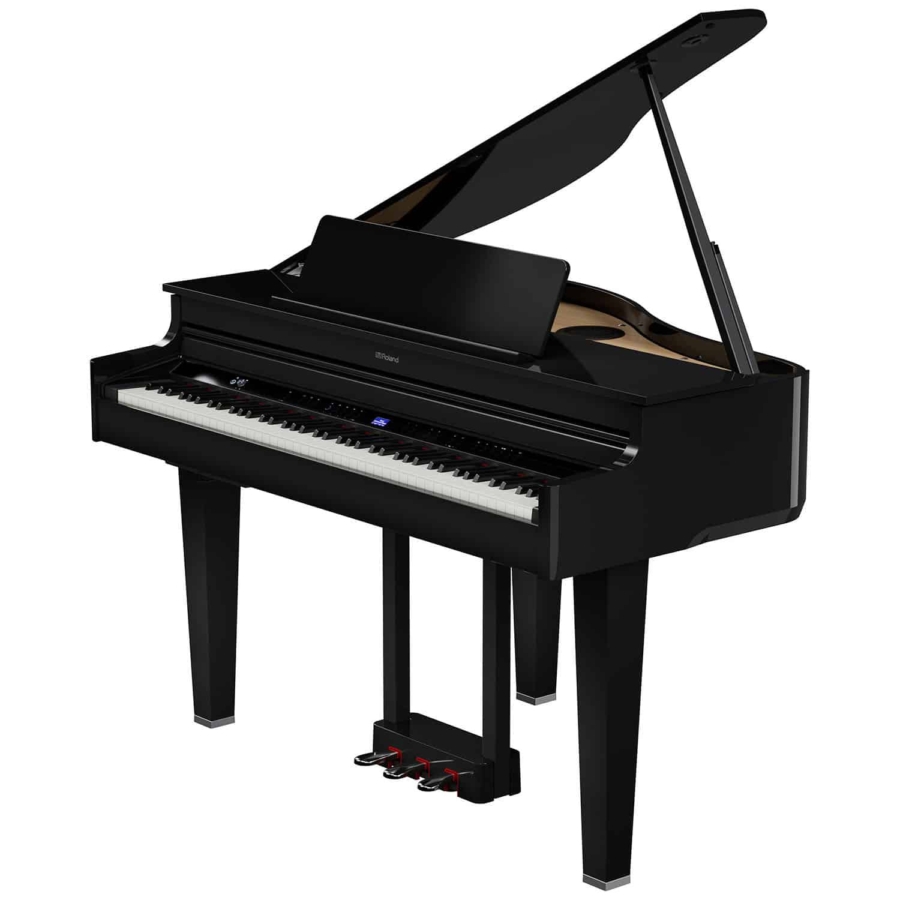
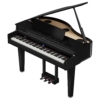
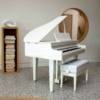
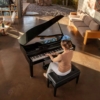
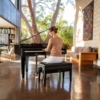


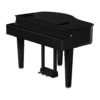
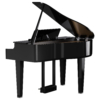

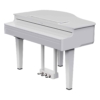

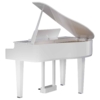
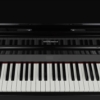
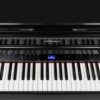
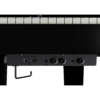
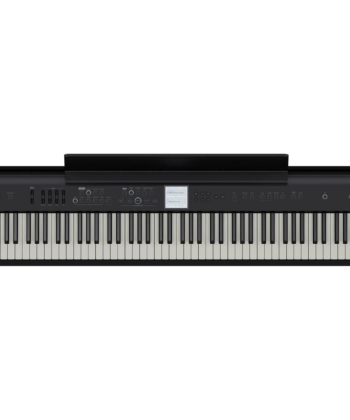
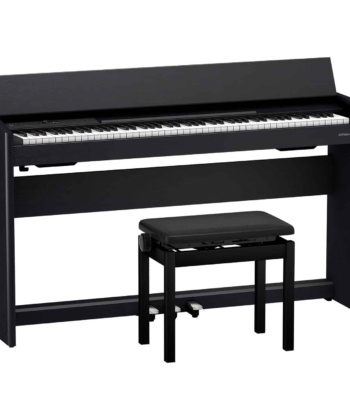
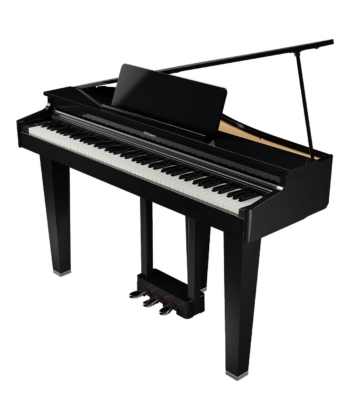
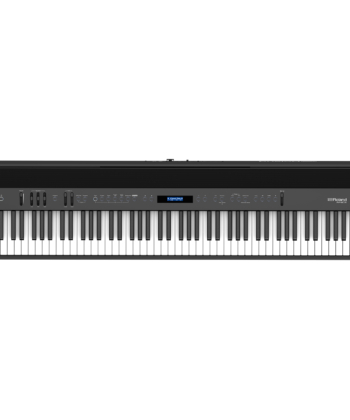


Reviews
There are no reviews yet.